




IN THE FALL ISSUE OF FRESH PICKINGS MAGAZINE, YOU’LL FIND STORIES THAT CELEBRATE THE INCREDIBLE FOOD, FARMS AND FAMILIES THAT MAKE IOWA A SPECIAL PLACE TO LIVE.
THIS QUARTERLY PUBLICATION IS BROUGHT TO YOU BY THE IOWA FOOD & FAMILY PROJECT. WE ARE AN INITIATIVE THAT INVITES IOWANS TO EXPLORE HOW FOOD IS GROWN AND RAISED AROUND THE STATE AND MEET THE FARMERS WHO MAKE IT HAPPEN, 24/7, 365 DAYS A YEAR.
WE NETWORK WITH NEARLY 35 FOOD, FARMING AND HEALTHY LIVING ORGANIZATIONS THAT ARE PROUD OF IOWA’S HOMEGROWN FOODS AND HOMETOWN VALUES. YOU CAN LEARN MORE ABOUT OUR PARTNERS ON PAGE 5.
20


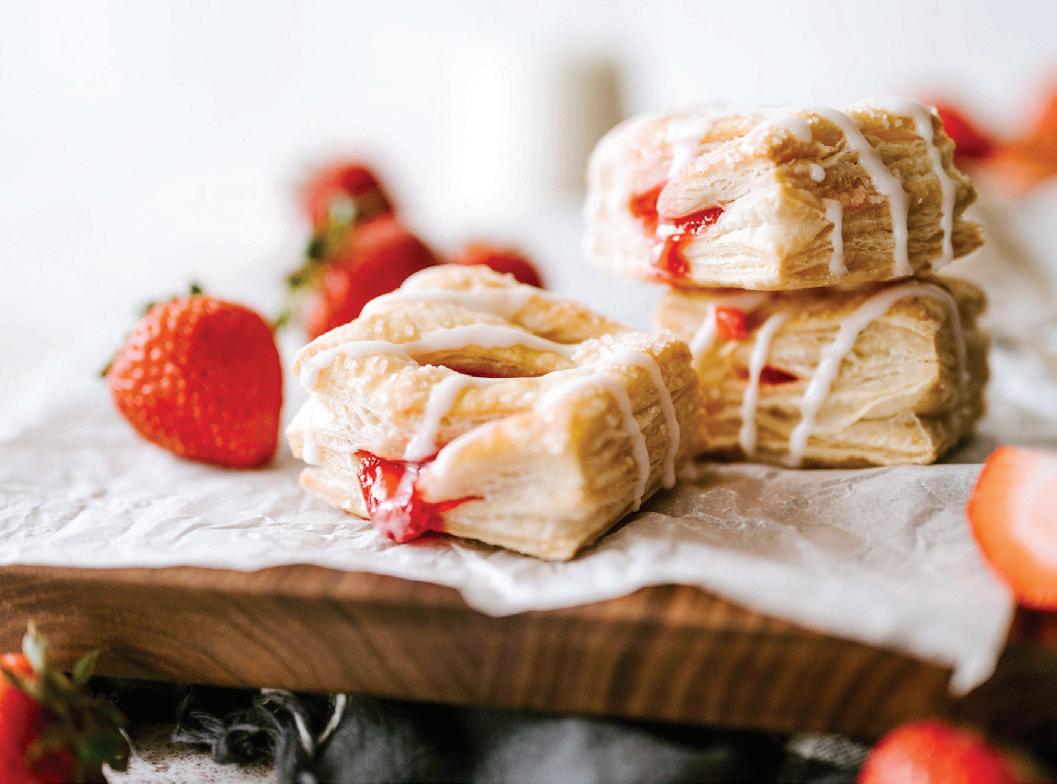
Once staples in all cities, independent grocery stores are dwindling, but three small-town Iowa stores are bucking the trend.
20 HAUNTING HISTORY
As the days get shorter and dusk casts eerie shadows, learning about Iowa’s haunting history can be a thrilling fall activity.
26 POWERING AG
What’s innovation? Imagining the future and filling in the gaps. See how the Ames-based Ag Startup Engine team powers entrepreneurs across Iowa and the Midwest.
32 WHEN PREMIUM PASTRIES ARE A FAMILY AFFAIR
Find out how Dutchland Foods has grown from a small family business into a major player in the frozen pastry industry.
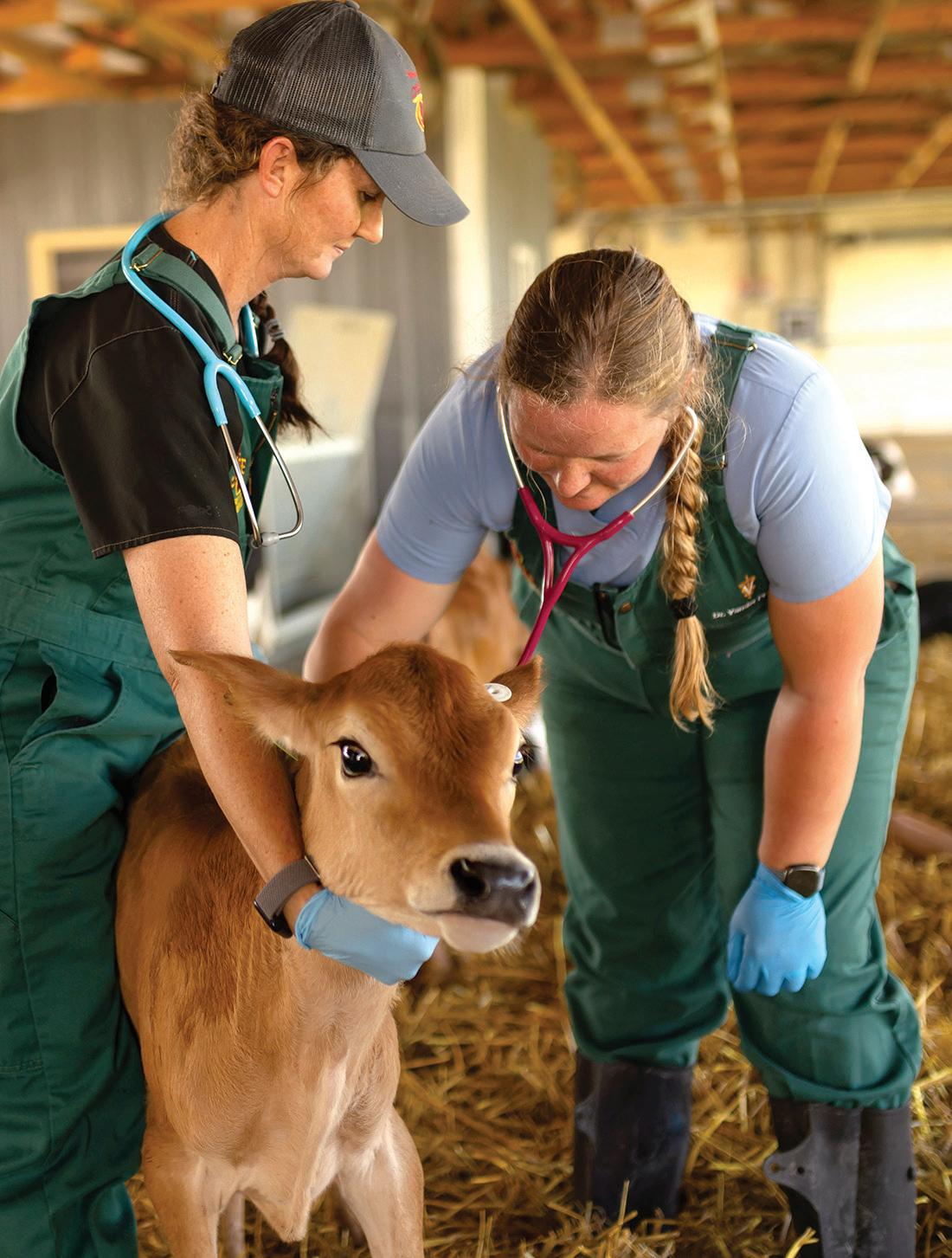
36 THESE DOCS MAKE BARN CALLS
Iowa has long been a leader in veterinary medicine. When large animals need specialized care, Iowa State University’s Lloyd Veterinary Medical Center team makes “barn calls.”
40 FLAVOR FUSIONS
Embark on a culinary adventure that tantalizes your taste buds with bold and savory flavors while igniting your kitchen creativity.
44 RECONNECTING WITH AGRICULTURE IN THE CLASSROOM
In Iowa schools, educators are taking advantage of free lesson plans that connect students with agriculture — something Americans feel more disconnected from than ever.
7 EDITOR’S NOTE LEAD WITH LOYALTY
8 FAMILY TABLE FALL FOR CARAMEL APPLE CHEESECAKE
11 GARDEN TIPS PLAN FOR COLOR COME SPRING
12 POINT OF INTEREST ORPHEUM THEATRE
48 FRESH PICKED BACK TO THE BASICS WITH HOME FOOD PRESERVATION
ON THE COVER
Leah Brooke, registered dietician nutritionist, has a passion for using her agricultural background to show how farm-raised products contribute to overall health and well-being.

BROUGHT TO YOU BY THE IOWA FOOD & FAMILY PROJECT
EDITOR
LYDIA ZERBY
PHOTOGRAPHER
JOCLYN BUSHMAN
DESIGNER
BRIANNA SCHECHINGER
APRIL PEARSON
April Pearson Creative
CRISTEN CLARK
Food & Swine
DARCY MAULSBY
Darcy Maulsby & Co.
HALEY BANWART
Farm Roots & Chore Boots
ALEX POTTER
Wixted & Company
GRETCHEN WESTDAL CENTERS
GWC Creative
LEAH BROOKE
ISU Extension and Outreach
FOUNDERS
Iowa Soybean Association
Iowa Beef Industry Council
Iowa Pork Producers Association
Midwest Dairy
Iowa Corn Growers Association
Iowa Poultry Association
Iowa Egg Council
Iowa Turkey Federation
The Soyfoods Council
SUPPORTERS
Anderson Erickson Dairy Cargill
Cookies Food Products
Corteva Agriscience
Earl May Garden Centers
Farm Credit Services of America
Heart of America Group
Hy-Vee
Iowa Grocery Industry Association
Iowa Machine Shed Restaurant
Iowa State Fair
Key Cooperative
Latham Hi-Tech Seeds
Live Healthy Iowa Subway
REQUEST YOUR MAILED SUBSCRIPTION AT IOWAFOODANDFAMILY.COM/MAGAZINE/SUBSCRIBE
Thank you to the Iowa Soybean Association, Iowa Beef Industry Council, Iowa Pork Producers Association, Midwest Dairy, Iowa Corn Growers Association, Iowa Egg Council, Iowa Turkey Federation, Farm Credit Services of America, Cargill, Corteva Agriscience, Key Cooperative, Latham Hi-Tech Seeds, Live Healthy Iowa and Earl May for the financial investment that makes this publication possible.
Fresh Pickings is published four times a year by:
Iowa Soybean Association, 1255 SW Prairie Trail Parkway, Ankeny, Iowa 50023
For advertising information, complete the form at iowafoodandfamily.com/magazine/feedback
Advertising space reservations must be made through the above form. In consideration of the acceptance of the advertisement, the agency and advertiser must, in respect of the contents of the advertisement, indemnify and save the publisher harmless against any expense arising from claims or actions against the publisher because of the publication of the content of the advertisement.
Comments: iowafoodandfamily.com/magazine/feedback




1 out of 5 rows of soybeans grown in the state are consumed by pigs raised in Iowa.
531,317 tons of soybean meal is consumed by Iowa’s laying hens per year.
One-third of a bushel of soybeans is consumed by each individual turkey raised in Iowa.

When I think about the audience the Iowa Food & Family Project (Iowa FFP) has amassed in its 12 years of existence, several words come to mind: engaged, curious, intelligent and loyal, to name a few.
Each month, Iowa FFP connects with over 150,000 Iowans who are interested in discovering more about the food, farming and agriculture that makes our communities and state so unique.
Iowa FFP successfully aims to increase trust in modern agriculture because of loyal partners who collaborate, farmers and business owners who willingly share their stories, and consumers who remain open and curious about how food gets from the farm to their tables.
Loyal partners such as Iowa commodity organizations, healthy living groups, local restaurants and more are vital to bringing Iowa FFP’s audience a wide variety of story topics, expert advice and new, exciting places to visit. I’ve learned Iowa is very fortunate to
have this type of collaboration. Everyone puts the mission first and knows what’s good for one group, helps lift others to greater success.
Farmers and business owners show loyalty to Iowa FFP by entrusting our writers with their stories, our photographer with their image and the entire Iowa FFP team with the job of promoting and sharing the final product far and wide.
And then there’s you, the Iowa consumer. We are so grateful for your loyalty to Iowa FFP. Whether it’s faithfully reading monthly content, engaging with social media posts, entering our promotional contests, attending in-person events like the Iowa State Fair or sharing our project and mission with your friends. We truly have the best audience and promise to continue searching far and wide to bring you content that inspires, challenges, engages and informs you of all that Iowa agriculture and our communities have to offer.
Have a story idea? Need a question answered by an expert like a farmer or dietitian?
We would love to hear from you. Send us a note here: www.iowafoodandfamily. com/about/contact. We thrive on two-way communication, and what’s important to Iowa consumers is important to us!
Enjoy the issue,

Enjoy a show at the historical Orpheum Theatre in Sioux City. Enter to win at iowafoodandfamily.com/contest/orpheum-theatre
By Cristen Clark

Baking a beautiful cheesecake may seem intimidating. However, with a little guidance on ingredients, timing and technique, this dessert can be easy to create. Creating a decadent cheesecake requires a blend of patience and attention to detail to achieve the velvety texture that melts in your mouth with every indulgent bite.
The first step to baking a flawless cheesecake begins with the crust. Whether you prefer a classic graham cracker base or a more adventurous crust with nuts, ensuring it’s properly prepared and constructed is crucial. Use melted butter and sugar to bind the graham cracker crumbs evenly. Press the crumbs firmly into the base of the pan and par-bake them. This prevents crumbling when serving and provides a sturdy foundation for the filling.
Next comes the filling — the heart of any cheesecake. The key to a smooth, creamy filling lies in the ingredients and their proportions. Cream cheese should be at room temperature to ensure it blends seamlessly with sugar and eggs. Beating the cream cheese until it's smooth and free of lumps is essential; however, overmixing introduces air bubbles that lead to cracking during baking.
When incorporating room temperature eggs, add them one at a time, mixing until just combined. This gentle approach helps maintain the desired texture. Once the filling is prepared, pour it onto the prepared crust and tap the pan gently on the counter to release any trapped air bubbles.
Baking cheesecake requires a special oven environment. A water bath helps regulate the oven temperature and prevents cracks in the top. If you don’t have a large enough baking dish to fit the cheesecake in, set an 8-inch square baking dish or pie plate filled halfway with water next to your baking cheesecake. Cheesecake continues to cook as it cools, so turn off the oven and let the cheesecake rest with the door cracked open to gradually cool down.
Chilling is the final step in the journey to cheesecake perfection. Refrigerate cheesecake for at least 4 hours, preferably overnight, to allow flavors to meld and the texture to firm up. This also makes it easier to slice cleanly. Wait until the cheesecake is completely cooled to add final toppings.
Ultimately, cooking the perfect cheesecake is about respecting the process — patiently mixing, baking and chilling to achieve a rich, creamy, and utterly satisfying dessert.

FOR THE CRUST:
• 12 sheets (1 package) graham cracker, crushed finely
• 2 tablespoons granulated sugar
• 6 tablespoons butter, melted
• 1 can (15 ounces) apple pie filling
FOR THE FILLING:
• 4 8-ounce blocks (16 ounces) regular cream cheese, room temperature
• 1 1/2 cups granulated sugar
• 1/2 cup sour cream (full fat)
• 1 1/2 teaspoon vanilla extract
• 4 large eggs, room temperature
FOR THE TOPPINGS:
• 1 can (15 ounces) apple pie filling
• Caramel sauce (roughly 1/4 cup)
• Homemade whipped cream
• 1/2 teaspoon vanilla extract
• 1 1/2 cups heavy cream
• 1/4 cup powdered sugar
• 1 tablespoon sour cream
Preheat oven to 350 degrees F. Line the bottom of a 9-inch springform pan with foil. In a large zip-top bag, crush graham crackers until fine. Add sugar and butter, mash in zip-top bag to combine. Pat the graham cracker mixture into the bottom and up the sides 1-inch in the springform pan. Bake in a preheated 350 degrees F oven for 11–12 minutes until graham cracker crust is golden and fragrant. Remove the crust from the oven and set aside.
Prior to pouring cheesecake filling into the graham
cracker crust, arrange the apples from one can of apple pie filling neatly in one layer on top of the par-baked crust.
In a large mixing bowl, gently beat cream cheese, sugar, sour cream and vanilla. Add the eggs one at a time, beating only until incorporated after each addition. Pour the cheesecake mixture into the par-baked, apple-topped graham cracker crust. Place cheesecake in the oven on the middle rack. Place a baking dish filled with 3 cups of water next to the cheesecake.
Bake cheesecake for 70 minutes at 350 degrees F. At that time, shut off the oven and open the door a quarter of the way to cool the cheesecake slowly to prevent cracking. Cool this way for 1 hour, then set on counter until cheesecake is closer to room temperature. Place the baked cheesecake in the refrigerator to chill for 4 hours or overnight.
When preparing to serve, chop apples with a butter knife while they are still inside the apple pie filling can and add them to the top of the well-chilled cheesecake. Whip together the whipped cream ingredients in a large mixing bowl until soft peaks form. Pipe whipped cream around the topping, drizzle with caramel sauce and sprinkle with cinnamon, if desired. Serve the cheesecake well-chilled.

Fall is ideal for planting trees, shrubs and perennials. Moderate autumn weather promotes root growth, resulting in larger plants and more flowers in the spring. When hot weather rolls around, these plants will be prepared to endure intense summer conditions.
Fall is ideal for planting trees, shrubs and perennials
By April Pearson
7 tips for planting this fall
1 PICK THE RIGHT PLANTS. The USDA Plant Hardiness Zone Map divides the U.S. into 13 zones based on winter temperatures. The lower the number, the lower the temperatures. Iowa is in Zone 5, so choose Zone 3 or 4 plants to be sure they can survive an Iowa winter. Ask your local Earl May experts for plant recommendations!
2 CHOOSE THE RIGHT TIME. Plant trees, shrubs and perennials between mid-August
and early October to give roots a chance to develop before the first hard frost.
3 SELECT THE RIGHT SPOT. Consider your plants’ preferences for sun, wind and moisture. For example, don’t place a plant that likes well-drained soil in an area that gathers rain and melted snow.
4 PREPARE TO PLANT. Clear away any leaves, rocks and grass from the area. Dig a hole that’s about as deep and twice as wide as the plant’s container.
Carefully slide the plant out of the container.
5 PLANT YOUR PLANTS. Place your plant in the hole to ensure the top of the root ball is even with the top of the hole; adjust as needed. Tease the roots apart so they can grow more quickly and easily. Position the plant with its “good side” facing out. Backfill with the soil you removed, packing it around the roots.
6 TAKE CARE. Water your plant and surrounding
soil to saturate the root ball. Add a thick layer of mulch to the bed to conserve water and insulate the soil. Keep your plant well-watered until the first hard frost — they’re hard at work establishing roots.
7 SKIP THE SNIP. Wait until spring to cut back stems and leaves killed in the frost. The plant will reabsorb nutrients from the dying foliage, improving its cold hardiness.

EXPERIENCE THE TIMELESS ELEGANCE AND ALLURE OF SIOUX CITY’S HISTORIC ORPHEUM THEATRE.
By Haley Banwart
Entering the Orpheum Theatre in Sioux City is like waltzing into a living tapestry of history and artistry. Since its grand opening in 1927, the performing arts venue has been a cornerstone of culture and entertainment, drawing audiences with its promise of spectacle and grandeur.
Celebrated for its ornate architecture and historical significance, the Orpheum Theatre remains an important fixture of the Iowa arts scene. Its story unfolds like a melodrama in three parts, echoing tales of a bygone era when vaudeville acts and silent films graced its stage.
The Sioux City Orpheum was constructed as part of the Orpheum Circuit, a prominent vaudeville entertainment network established around the turn of the 20th century. Renowned for its lavish theaters, the Orpheum Circuit booked acts with top-tier talent, costumes, props and variety.
At the time of its debut, the Orpheum Theatre was the largest in the state. The opulent vaudeville and moving picture house featured a 2,690-seat, six-story auditorium,

complete with a pipe organ, half-circle seating boxes, hand-carved detailing, gilded ornamentation, crystal chandeliers and a hand-painted ceiling.
Audiences were treated to a wide array of entertainment, including symphony performances, ballet shows and special attractions featuring prominent entertainers of the time. In its heyday, the stage came alive with the talents of legendary figures such as Fred Astaire, Katharine Hepburn and Kirk Douglas.
In the 1970s and ‘80s, the Orpheum Theatre was remodeled into a one-story movie house. It was later divided into a two-screen theater, and much of its original architectural detailing was covered over or removed. The building was closed to the public in 1992.
Facing the threat of its final curtain call, the Siouxland community stepped up to save the treasured theater. The Orpheum Theatre Preservation Project, Ltd. (OTPP) was established to spearhead fundraising for its renovation. Restoration efforts began in 1999 with a team of local and national experts.

“The community was invested in preserving the rich history, architecture and level of excellence the theater was known for,” says Emily Vondrak, director of marketing with Oak View Group, the global sports and entertainment company that manages the Orpheum Theatre. “Meticulous planning and attention to detail went into returning the Orpheum to what it would have looked like on its opening day. Original features were restored, period pieces were sourced and replications were made.”
After two years of extensive restoration, the Orpheum Theatre reopened its doors on Sept. 15, 2001. Today, an impressive lineup of performances continues to captivate theatergoers, bringing a touch of Hollywood glamour and Broadway prestige to audiences in the heart of the Midwest.
“The legacy of the Orpheum Theatre endures as a pillar of arts and entertainment, bringing in high-level acts that would not normally be accessible in a community of this size,” says Vondrak. “Efforts to restore the theater and support its ongoing endowment are a testament to its cultural significance in the Siouxland area.”



In three different parts of the state sit three different men. What they lack in geographic proximity, they more than make up for in dedication to their communities.
Meet Garren Zanker, Tom Mulholland and Doug Alberhasky. They’re business owners, independent grocers and proponents of showing up for their communities.
The independent, locally owned grocery store — which used to be a staple in towns large and small — has dwindled as competition from national chains and online shopping hampers their ability to thrive.
That doesn’t stop Zanker, Mulholland and Alberhasky. They understand it’s just part of the business. But, of course, they’re in it for more than profit. They see their work as vital to their communities’ prosperity and success.
Stop into Jewell Market during the lunch hour, and you might be able to secure one of the homemade specials for the day. Not only is Jewell Market a full-fledged grocery store, but it also offers a hot grab-and-go lunch for people on busy days. It’s just one of the ways Garren Zanker, owner and manager of Jewell Market, diversifies the business to meet and exceed the customer demand of Jewell residents.
Zanker knows a thing or two about customer demand. He started working at Anderson's Meat and Grocery (in the same building) in 1994. It was his first job. He’s been in the grocery business most of his life — after 23 years in a couple larger chain grocery stores and a bank were his only times away from the store that would become the Jewell Market.

By Gretchen Westdal Centers

“TIME
IS A COMMODITY. AT THE END OF THE DAY, WE ARE HERE SO THEY HAVE SOMEONE TO RELY ON.”
GARREN
ZANKER


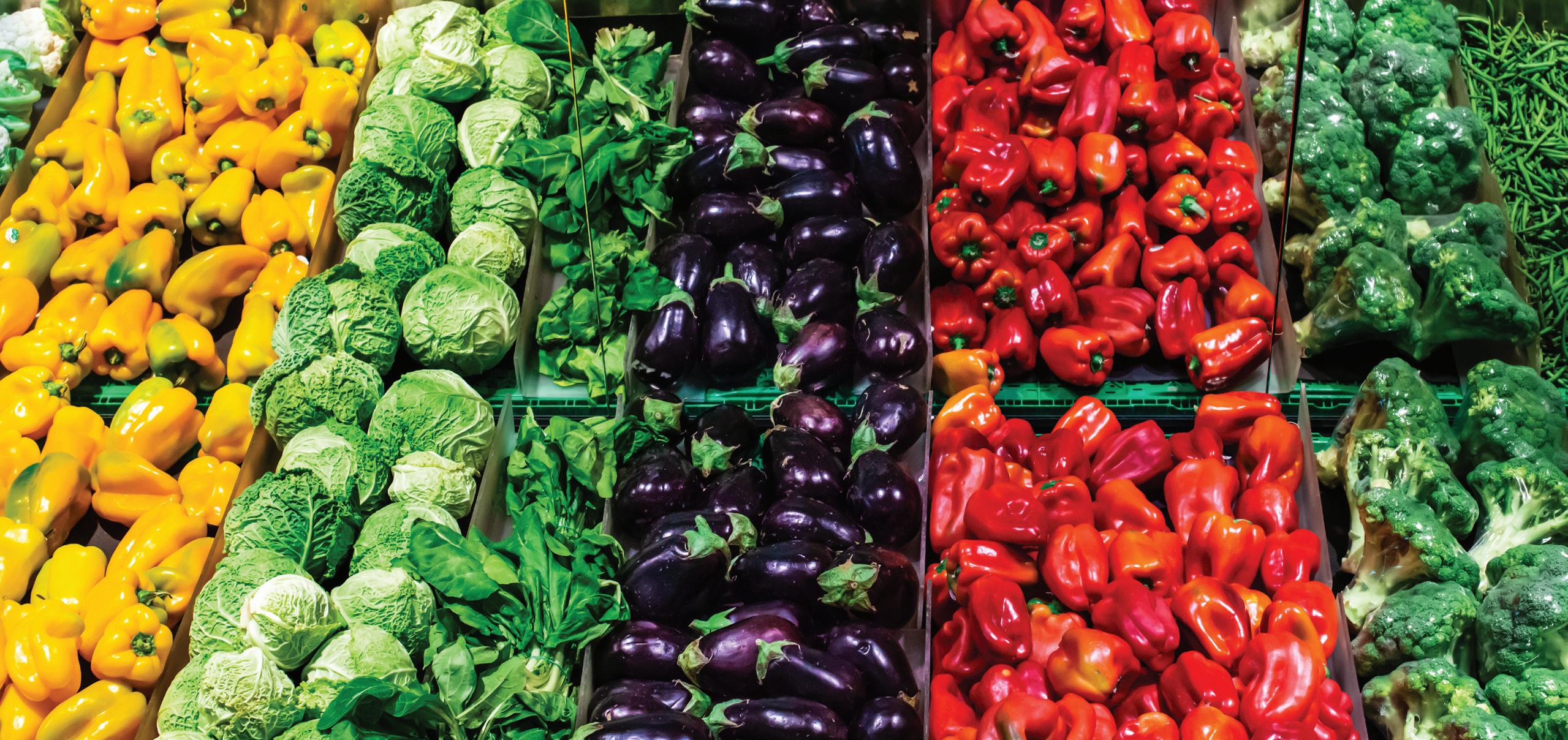
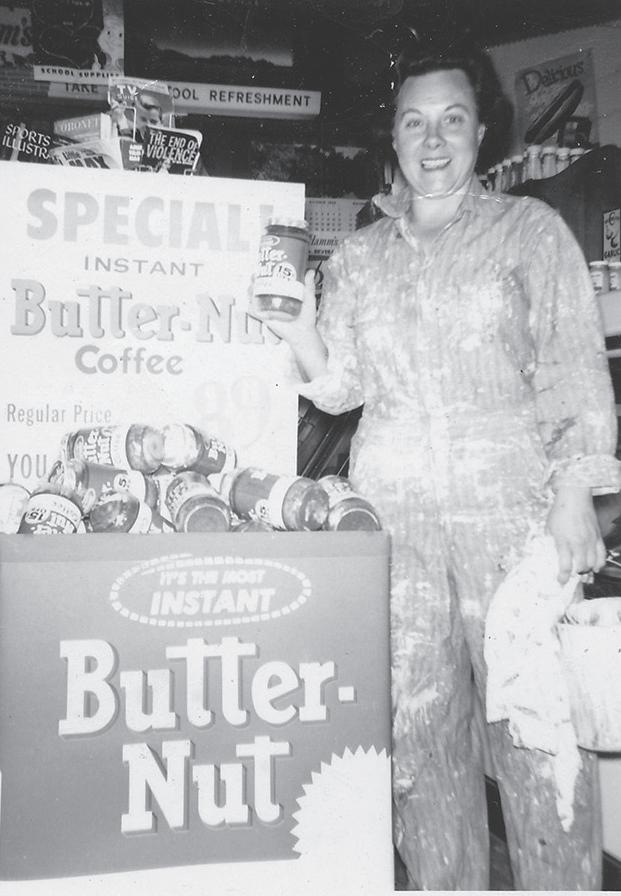
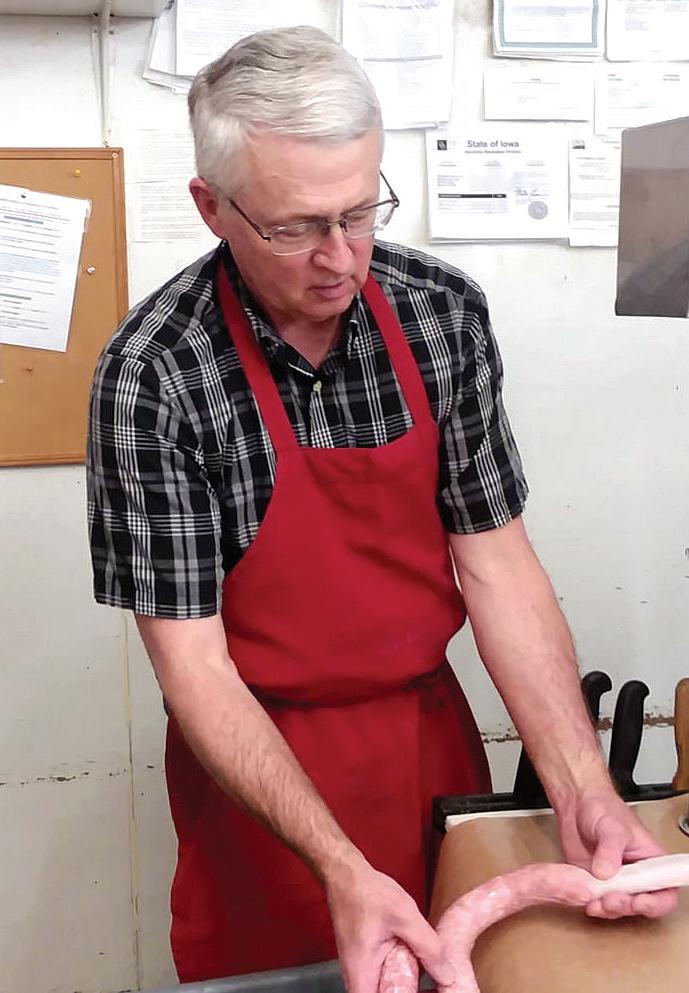
His attention to the customer revealed a way to save Jewell Market, which was on the brink of closing in 2019 after previous management issues. Zanker stepped in to help because he knew the community, his hometown, needed the store. On Jan. 1, 2020, a group was formed to save it.
Through community fundraising, they remodeled the market and started thinking
about restocking shelves. They were seeing good progress. Then, the COVID-19 pandemic hit, and momentum halted. The group started brainstorming, knowing that they couldn’t stop.
“We had this idea to do drive-through meals,” recalls Zanker. “Nobody could go out to eat, so we saw an opportunity for people to leave their houses and help support the
“WE SUPPORT THE COMMUNITY. AND THE COMMUNITY SUPPORTS US; THAT'S JUST HOW IT IS.”
DOUG ALBERHASKY
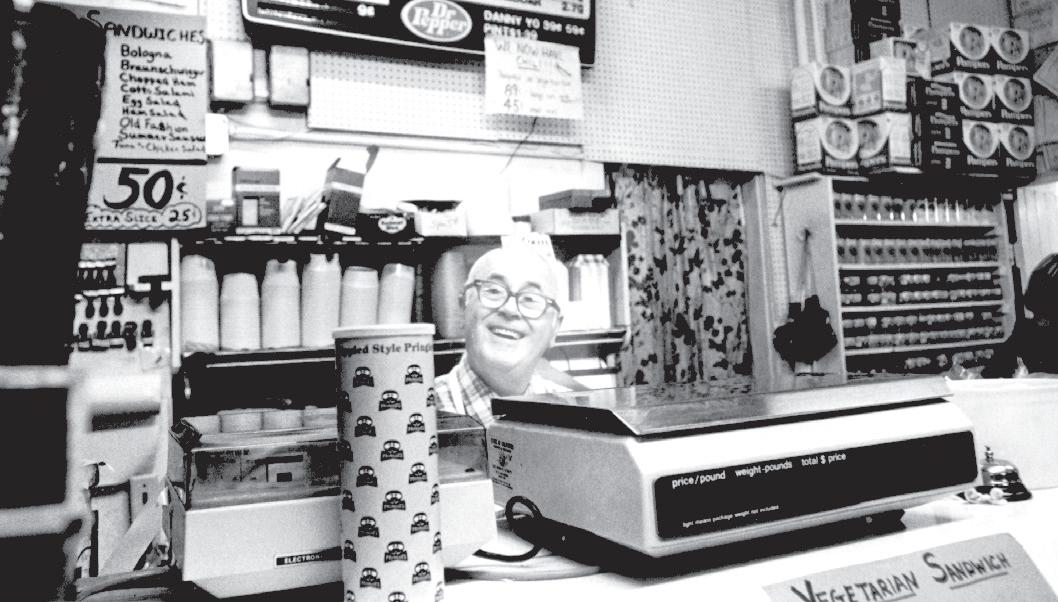
store safely. We started with hot dogs and hamburgers and sold out in 45 minutes.”
Each time the store prepared and sold meals, they continually sold out. By Easter, Jewell Market had people lining up weekly to buy the prepared meals and drop money in the store’s donation jar.
“We raised a lot of money that way. By May, we had enough and proceeded to fully reopen the store,” Zanker explains. “The store reopened in July 2020.”
In just seven months, the town of Jewell saved their only grocery store.
Today, the market still sells lunch. Coupled with the fresh produce, full meat counter and fully stocked shelves featuring local Iowa products, Jewell Market is thriving. Zanker is looking for ways to expand the operation by adding seating to the store so patrons can enjoy meals together. The grocery store is much more than a place to pick up items for supper.
“It’s a central hub for the community,” Zanker elaborates. “Farmers coming and going. People on their lunch breaks, parents getting their kids to sports and activities. Time is a commodity. At the end of the day, we are here so they have someone to rely on.”

“I AM THE FOURTH GENERATION OF MY FAMILY TO HAVE THIS STORE. ... WE BUILT AN EXCELLENT REPUTATION THROUGHOUT THE STATE AND THE COUNTRY.”
TOM MULHOLLAND



Family Affair at John’s Grocery
The state of Iowa was established in 1847.
A year later, a dry goods store opened at the corner of Market and Gilbert and has been serving generations of Iowans ever since.
Over the years, ownership has passed through different families. In 1948, Doug Alberhasky’s grandparents purchased the then-100-year-old business. At age six, Doug started working there under the watchful eyes of his grandparents and parents. Now, Doug has welcomed his son JD into the business as generation number four.
It’s been an Iowa City tradition and institution for more than a century because of the family’s continued dedication to the store and the community.
“My story is no different than that of any other small business owner because we’re part of the community,” Alberhasky explains. “We live in the community. We support the community. And the community supports us; that’s just how it is. We’ve seen corporations try to create competition, and the community has always rallied around us.”
That community is well represented in the store. Alberhasky stocks the shelves with an extensive array of Iowa-made products, fine wines, beer, spirits and pantry staples that can round out a gourmet dinner or feed a hungry college student.
For 150 years, Mulholland Grocery stood as a cornerstone of the Malvern community. Until tragedy struck. A massive fire destroyed the store in December 2021. Malvern was left without a grocery store, and owner Tom Mulholland was left without his mooring.
“I had the business for about 15 years before the fire occurred,” explains Mulholland. “I am the fourth generation of my family to have this store. I knew that small-town grocery stores were a dying breed, and it was a very tough market because of competition. But we built an excellent reputation throughout the state and the country.”
Through innovative marketing, word of mouth and quality products — especially their specialty meats — Mulholland Grocery prospered. But one aspect propelled the store’s success: Mulholland’s focus on doing the right thing.
In 2020, the neighboring town of Glenwood flooded, and the water treatment plant was submerged.
“The day they lost their water treatment plant, we had just received a shipment
of water,” remembers Mulholland. An employee and I loaded up my pickup and delivered it to Glenwood. There were so many who had lost their homes and were living in shelters, and there were things that were needed. We started working with my warehouse to get them food and supplies.”
Malvern residents and past business associates of Mulholland learned of his actions and started sending donations. Not only had he built a local community of people in Malvern who knew of his giving nature, but Mulholland also had an extensive online community. His goldstandard reputation of doing the right thing was solidified throughout the country. When the fire occurred, and the store was in ashes, Mulholland wasn’t alone. Donations started pouring in from all over.
“I had people walking up to me and handing me cash to help,” he remembers, his voice breaking with emotion. “It was very difficult to accept at first. I’m trying to help other people, and now, I’m the one who could really use it.”
A friend told him to consider it an investment in the community’s future, which made it easier for Mulholland to accept. By seeing the help as steps forward to rebuild not only his business but also a much-needed resource for the town, Mulholland got to work.
“I’m doing this because I want to be able to work there for the next few years and see my customers,” Mulholland explains. “I also want the community to be taken care of for the next 20 or 30 years.”
The road back hasn’t been easy, but Malvern residents and Mulholland’s extensive network have been supporting the man who’s supported them for so long. Together, under Mulholland’s dedication and care, Mulholland Grocery will serve as a pillar of the Malvern community.
The store is set to reopen in December 2024 — the perfect Christmas present.


Iowa’s history runs deep, but some of the stories can spook — reader beware .
By Gretchen Westdal Centers

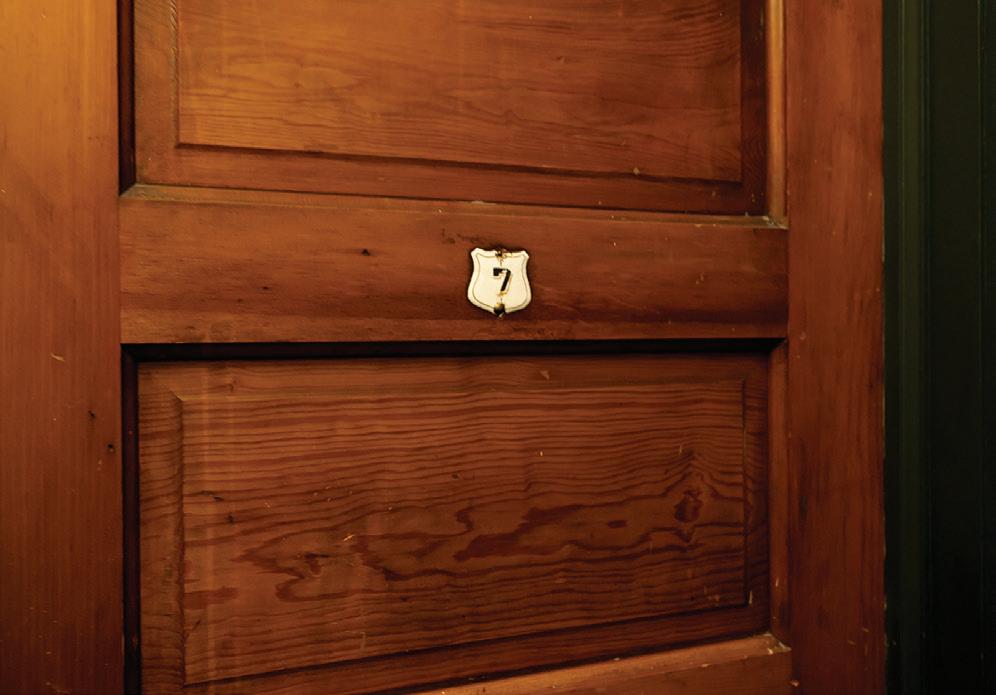




There’s a sudden chill. Your skin prickles. All your senses are at full attention. Any sound has your heart racing. Your mind runs wild.
You’re spooked.
Some people love the sensation. Some people avoid it as best they can. From ghost stories around the campfire to gory horror movies, humans have been intrigued by that which can’t always be explained.
There’s a psychological response from being scared that releases cortisol and adrenaline. When the threat is gone, a rush of dopamine — the feel-good hormone — can be released, giving the person a rush or high.
Like most everything, a healthy scare or feeling spooked can be exhilarating when done in moderation. And, as fall creeps its way in — daylight receding, the trees shedding their leaves to reveal skeletal branches, the cool air — it’s the perfect time to find a spooky spot to explore.
Luckily, Iowa has some infamous, and some lesser-known, haunts that will leave you looking over your shoulder. So, pack up the car with your favorite snacks, flashlights, and your courage to explore and learn about the spookier spots around Iowa.
1. Hotel Ottumwa Ottumwa
2. Farrar Schoolhouse Farrar
3. Stony Hollow Road Burlington
4. Mason House Inn Keosauqua
5. Cresco Theatre & Opera House Cresco
6. Mathias Ham House Dubuque
7. Malvern Manor Malvern
8. Squirrel Cage Jail Council Bluffs
9. Hazel Green Cemetery Ackley

AS FALL CREEPS ITS WAY IN, IT'S THE PERFECT TIME TO FIND A SPOOKY SPOT TO EXPLORE.



In the early 1800s, life on the farm was not for the fainthearted. Farmers today know the stress and work of maintaining a successful operation. So, many can only imagine the toil that came when work was done by only hand and skill.
And for those who weren’t able-bodied or didn’t have the skills available to farm, life was even more difficult. In those times, county poor farms were established across rural U.S. communities as places for those classified by the time period as “poor, incurably insane and disabled” to go and work. Those who lived in these houses were given food and shelter in return for labor.

Edinburgh Manor in Jones County was established in 1840 at section 36 in Wayne Township, where it was described as a comfortable retreat for “the lazy, ablebodied and willingly dependent applicants.” Comfortable may be a stretch as residents were referred to as inmates. They were free to come and go as they pleased, but with no other option for those who were experiencing severe mental illness, homelessness or those who were disabled, where could they go?
Many didn’t go anywhere. Over the years it was in operation, from 1840 up until 2010, it’s
purported that Edinburgh Manor saw more than 230 deaths on the property. And many visitors say those souls still haven’t left the property.
Today, the building still stands and has the relics of previous occupants and workers. Edinburgh Manor is now privately owned, and the operators allow a set number of tours and overnight visitors during the year. For those who’ve gone, many recount stories of hearing far-off singing and coughing when they are the only humans present. People report seeing faces — not belonging to anyone in the visiting group —


appearing in mirrors and other eerie experiences.
It's a sobering experience visiting Edinburgh Manor. Reminders of past lives lived in hardship and, perhaps, those still trying to tell their stories.
A stately red-brick building with a bustling restaurant that

serves patrons from sun up to sun down, the Franklin Hotel seems like a charming, historical building preserved as time and trends rush by. Lining a main thoroughfare of Strawberry Point, the Franklin Hotel has been in business since 1902.
The property dates back to 1853, when it first served as a station stop for men working on railroad construction. Throughout its
history, the Franklin Hotel has served many visitors and guests, and a couple of them seem to have made a permanant residence.
Legend has it that a woman named Lily and a former merchant haunt the halls. Hotel guests report objects being moved around their rooms. Clothes that have been purposely hung up drop off hangars without known cause. Disembodied voices and singing are heard. And, most unsettling, faces — that don’t belong to anyone of the present day — have appeared in mirrors.
Whether you visit the hotel for a trip to the restaurant after a day of hiking and admiring the vibrant fall foliage in Backbone State Park or you stay the night for potential

spooky sights, you’ll be enjoying a historic haunt of Iowa.
The Black Angel Statue — Council Bluffs
Legends and lore can cast a shadow over sacred places and give people an unsettling feeling. As with any location that has endured heartbreak, loss or a turbulent event, reverence and respect should be paid to the area.
The Black Angel Statue of Council Bluffs was commissioned by the daughters of Ruth Anne Dodge, wife of a Civil War general and railroad builder, upon her death in 1916. The story goes that Ruth Anne experienced three dreams on the three nights preceding her death. In those dreams, she said an angel appeared and comforted her. To honor their mother, her daughters wanted an angel constructed to stand as the same comforting symbol their mother saw in her dreams.
Daniel Chester French was the artist commissioned for the work. He also sculpted Abraham Lincoln for the Lincoln Memorial in Washington D.C. and created other significant monuments. French used a woman named Audrey Munson as the model for

the angel. Munson was considered the first U.S. supermodel. She sat and posed for many sculptures and works of art throughout the U.S.
Everything from Council Bluff’s Black Angel to sculptures atop state capitol buildings to coins minted by the U.S. treasury. But, her life story is traumatic and troubling. She spent her later years in obscurity and poverty, confined to a psychiatric hospital until her death. Legend says she haunts the statues for which she modeled.
Originally cast in bronze, the Black Angel has patinaed to a rich black green. This only adds to the local lore around it. Whatever visitors may experience while there, it’s piece of art from a significant sculptor who contributed to some of the nation’s most famous landmarks and memorials, and the statue serves as a reminder of hope in troubling times.
Arguably the most notorious of Iowa’s spooky spots, the Villisca House has a dark and unnerving history. On the night of June 12, 1912, eight people were tragically
murdered. There are still unanswered questions about what happened to Joe and Sarah Moore, their four children, and two additional kids who were all sleeping in the home when a distraught individual came in wielding an axe that would end all their lives.
The family had no known enemies and were well-liked around town, so it was even more shocking when the gruesome scene was discovered. What sent the town into an even greater despair was the perpetrator was never found. Suspect speculation ranged from a deranged, traveling preacher to a prominent state senator. The mystery is still unsolved to this day.
In its 112-year history, Villisca House has been privately owned, but many of the occupants reported strange and frightening incidents. Today, Villisca House claims to be one of the most haunted places in America. The house was restored to what it looked like in 1912 and piques the interests of history buffs, true-crime fanatics and those interested in the paranormal. Visitors can go on tours where the paranormal may occur or, if they are really brave, stay overnight.
Iowa is filled with interesting and curious history. Taking the time to reflect on where we’ve been can help us look to the future with greater knowledge and appreciation for how far we’ve come and where we want to go. And, maybe, we’ll see signs from those who’ve come before us on the direction forward.
AG STARTUP ENGINE HELPS MIDWESTERN ENTREPRENEURS CREATE THE FUTURE, FROM FOOD TO FUEL
By Darcy Maulsby

Healthier soils that nourish healthier plants, livestock and people. Cleaner diesel engines that run efficiently — without petroleum-based fuel. Even Midwest-fresh shrimp.
Thanks to innovative thinking and dedicated entrepreneurs here in the Midwest, it's all becoming a reality. A growing number of these ag entrepreneurs are getting a significant boost to propel their startup companies to the next level, thanks to the Ames-based Ag Startup Engine.
“I appreciate the unique mindset required to be an innovator,” says Kevin Kimle, Director, Start Something - College of Agriculture and Life Sciences program at Iowa State University (ISU). “The Ag Startup
Engine team supports ag entrepreneurs and investors as they create solutions to solve real-world problems.”
In 1996, Kimle founded E-Markets, one of the first e-commerce platforms to focus on business-to-business commerce in ag. By late 2000, he created Decision Commodities to provide risk management for buyers and sellers of ag commodities.
“It’s like a hedge fund for pricing your grain,” says Kimle, who sold Decision Commodities in 2008 to GROWMARK, a regional agricultural supply cooperative.
Today, Kimle and the Ag Startup Engine team connect entrepreneurs with a network of successful entrepreneurs, business professionals and investors and early seed


round investment ($25,000–$100,000) to help companies scale their operations.
“This is risk capital that doesn’t go that far, although it can help fill in some gaps,” notes Kimle, who grew up on a farm in Nebraska. “If we invest $50,000 or $100,000, this can encourage other investors to get involved, too.”
The Ag Startup Engine team works with various innovators specializing in precision ag, animal health, ag tech, robotics and other ag-focused enterprises, including Continuum Ag. Based in Washington, Iowa, Continuum Ag is on a mission to help a million farmers improve their profitability through improved soil health.
“The Ag Startup Engine’s network and deep ag experience have been extremely useful,” says Mitchell Hora, CEO of Continuum Ag. “Financial support is great, but as a young entrepreneur, I really enjoy learning from


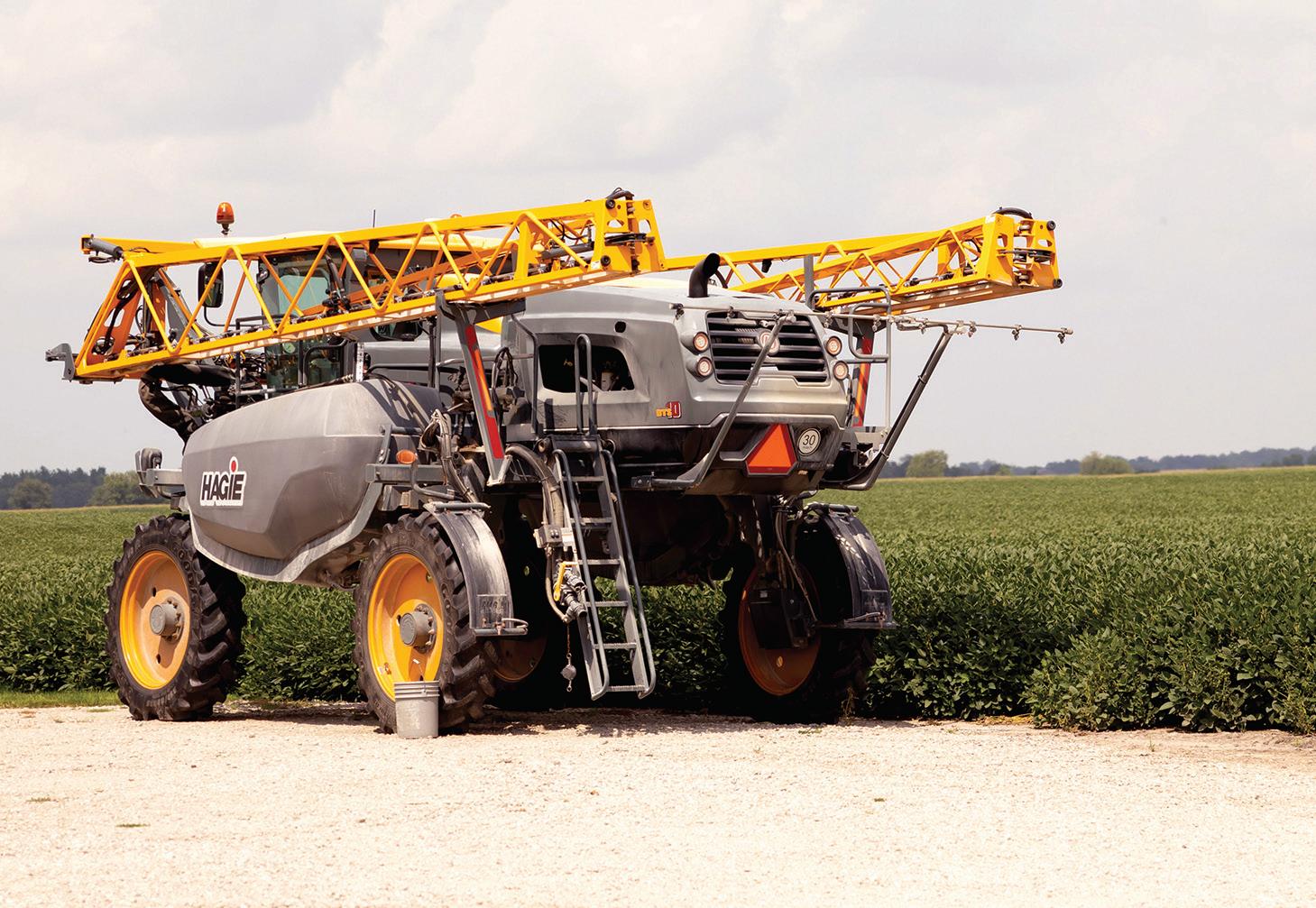

others. The fellow entrepreneurs and mentors within the Ag Startup Engine have been the real value to me.”
Continuum Ag helps farmers find ways to measure and improve soil health, a vital, living ecosystem that’s the foundation of productive, sustainable agriculture. While still in college, Hora founded Continuum Ag in 2015 as an agricultural consulting company. This taught him the power of partnerships and mentors.
“I got involved in the Agricultural Entrepreneurial Initiative — now called Start Something — while I was a student at ISU,” says Hora, who serves farmers across Iowa and beyond. “Through this network of aspiring entrepreneurs and university resources, I launched Continuum Ag with early success.”
After graduating from ISU, Hora kept in touch with his Ames network, including the Ag Startup Engine team. “When Continuum Ag started to look for some venture financing, I reached out to the Ag Startup Engine for a pitch. After honing in my business model and building the relationship over time, the Ag Startup Engine invested in Continuum. This has been a phenomenal group to have in my corner.”
Hora adds that this support helps grow a prosperous Midwestern economy. “Iowa should be the leader in ag tech. Capital, networks, mentors and go-to-market support are critical to make this happen. I love the leadership from the Ag Startup Engine and fully believe that Iowa is on a good trajectory to enable more ag innovation to flourish.”
The Ag Startup Engine’s team includes a wide range of talent serving as innovators. Mikayla Mooney, venture partner, began her journey as an entrepreneur at age 19 when she started the ag tech company KinoSol.
“We built solar-powered food dehydrators for farmers in developing regions,” Mooney says. “During the next six years as CEO, I led the company in launching our product in more than 50 countries.”
Mooney appreciates the opportunity to work with investors and entrepreneurs who are passionate about agriculture and food production. “Our investors and mentors through the Ag Startup Engine range from farmers and other individuals to leaders of various small- and mid-sized companies. They all want to pay it forward and help the next generation of ag innovators.”
Kimle’s son, Jackson, is one of the innovators. After earning his ag business degree from ISU in 2016, Jackson Kimle founded Midland Co., a land-based seafood technology company dedicated to raising sustainable, ethically produced, flavorful seafood.
“I heard about someone experimenting with growing shrimp in Iowa years ago,” says Jackson. “At the time, I was selling locally raised lamb to restaurants in central Iowa.
Talking with these chefs and visiting the seafood farm ignited my imagination. On top of that, the Iowa-grown shrimp was the best-tasting seafood I had ever had.”
Jackson and his business partner, Matt Ellis, worked with a farmer near Hampton in north-central Iowa to establish their seafood farm. Midland Co. shrimp are raised without hormones, antibiotics or chemicals. This seafood goes from tank-to-table within 24 hours.
Iowa-grown soybeans can play a vital role in the success of Midland Co., added Jackson, who is interested in sourcing soy ingredients from Iowa growers. “Shrimp diets currently include significant quantities of soy. New, innovative soy products can enhance inclusion rates and the profitability of shrimp farming here in Iowa.”
This is good news for Iowa soybean growers. “Our shrimp production technology is built to enable soybean farmers to diversify their operations,” Jackson notes. “This will add additional revenue streams for our state's farmers and increase demand for the products they already produce.”
The Ag Startup Engine is also helping propel the growth of another Midwest-based company, ClearFlame Engine Technologies. This firm is working to clean the air, one engine at a time.
“Engines are critical to today’s quality of life, from producing crops to moving the goods we use daily,” says BJ Johnson, founder of ClearFlame Engine Technologies.

"IT'S GREAT TO WORK WITH ASPIRING ENTREPRENEURS AND WATCH THEM GO OUT INTO THE WORLD AND MAKE A POSITIVE DIFFERENCE."
KEVIN KIMLE
“To curb pollution, the solution isn’t to get rid of engines in semi-trucks, tractors and other equipment, but make these engines more efficient.”
Johnson’s company is helping trucking companies cut costs and engine emissions by converting diesel engines to 100% ethanol. After founding ClearFlame Engine Technologies on the West Coast in 2016, Johnson relocated to Chicago. The Ag Startup Engine, with partners like Iowa Corn, has helped Johnson with funding.
“Traditionally, venture capital comes from California or Boston,” says Johnson, a Seattle, Washington, native. “The Ag Startup Engine was also critical in helping me build my Midwest network.”
The opportunity to grow ClearFlame Engine Technologies is tremendous, especially in the trucking industry. “In America, 60 billion gallons of diesel fuel are used each year, with 45 billion of those gallons in over-the-road trucking,” says Johnson, who earned his mechanical engineering degree from Stanford University. “While we’re focusing on trucking companies, our technology can fit anywhere you use diesel engines, including agriculture.”
It’s exciting to help support solutions like this that drive innovation in the Midwest ag sector, Kevin Kimle says. “It’s great to work with aspiring entrepreneurs and watch them go out into the world and make a positive difference.”


DUTCHLAND FOODS BRINGS OUT THE BEST IN BOTH
By April Pearson
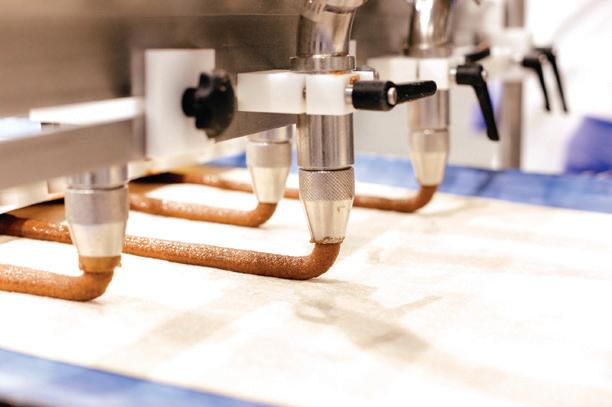
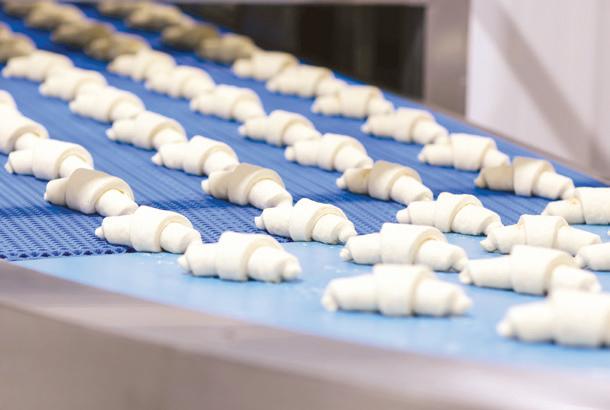
When the Van Wyhe family founded Dutchland Foods in 1992, little did they know their success would be measured in terms of excellent employees, a supportive community and a family legacy going into its fourth generation.
Susan and Pete Van Wyhe started Dutchland Foods with Pete’s parents, Jennie and Wayne, using family recipes and the best ingredients available to create quality pastries. Over the past 32 years, it’s grown into a world-class production facility, located in the Northwest Iowa town of Lester, housing sophisticated equipment and employing 100 people — including Susan and Pete’s sons Malachi, Monty and Mychal, and numerous grandkids.
Dutchland Foods creates delicious frozen pastries for four markets: private label, wholesale, retail and fundraising.
Private-label clients choose off-the-shelf Dutchland Foods products — or create custom pastries with the Dutchland Foods research and development team (R&D) — to sell under their brand name. “A new product starts in our R&D department with samples that we create and send to the client,” says Monty, sales and operations manager. “They test the samples and give

us feedback. The R&D process goes back and forth until we lock in a final product.”
Wholesale clients are restaurants, grocery stores, coffee shops and other businesses that cater to the end customer. Dutchland Foods offers various frozen, ready-tobake pastries for these businesses, from rich and tender Danish pastries to soft and golden French croissants. For retail customers, Dutchland Foods offers a light and flaky pie crust.
Fundraising clients are dealers and distributors that help school groups, daycares, youth dance teams and youth sports organizations raise funds for uniforms, equipment and trips. Dutchland Foods offers two products — Pastry Puffins and Butter Hearts — exclusively through fundraising channels. “Our Pastry Puffins have different fruit fillings, and everyone loves them; then our Butter Hearts are like palmier pastries, and those are really popular too,” says Savannah Meikamp, marketing manager.
Withholding these popular pastries from the public leads to greater fundraising success. “The scarcity creates demand,” says Mychal, finance and fundraising manager. “If they can't get it at the grocery store, they look for it year after year when the fundraiser comes around.”
for the purchase of Dutchland Foods Pappy’s Pie Dough. Enter to win at iowafoodandfamily.com/contest/dutchland-foods .



Made With Love. And Innovation.
Dutchland Foods runs a high-tech operation, but it wasn’t always that way. “When we started, we were doing everything by hand,” says Susan, cofounder and advisor.
As the business grew, they added machines to improve efficiency. Dutchland Foods has its own CNC mill machine, which can create custom parts for the equipment. “Instead of waiting for a three-month lead time on a certain part, we’re getting stuff made in a couple of days,” says Malachi, sales manager. “That’s really helped us stay innovative and nimble in the manufacturing space.”
Dutchland Foods is implementing enterprise resource planning (ERP) software to help with production, planning and inventory to run a smoother operation. Two years ago, they took a major plunge and invested in cutting-edge industrial baking equipment from the Netherlands and Italy.
All these advancements help streamline production, but do they come at the expense of quality?
“Once the product goes into production, we implement rigorous quality standards and tests throughout the day to ensure it’s meeting our specs,” says Monty. “We strive for high-quality performance from our machines and use highquality ingredients. That helps to make a premium pastry.”
Dutchland Foods’ quality doesn’t start and stop with production. It’s present from the concept phase of a new product through safety and cleanup.
“We have quite a few employees on our food safety team,” says Pete, CEO, “and we’ve gotten an AA rating from
the BRC (British Retail Consortium Global Standard) for food safety four years in a row.” The BRC assesses suppliers across a stringent set of criteria, including hygiene, safety and traceability of ingredients. AA is virtually the highest rating a business can earn. The only way to receive an AA+ is to earn an AA during an unannounced audit, which is exactly what Dutchland Foods did on the last inspection.
“We’ve gotten comments from inspectors, like, ‘Wow, this is the cleanest facility I've ever been in!’ We take pride in keeping our facilities clean and up to date,” says Malachi.
Dutchland Foods also takes pride in being a major employer in a small town. Lester’s population is 300, and most of the business’s employees are from the area. Those who become Dutchland Food employees have remained part of the operation for decades.
“We don't like to take too much credit,” says Pete. “We want to give the credit to the Lord, where it belongs, and to our wonderful employees.”
“We can’t say enough about our local employees,” says Susan. “We couldn’t do it without them.”
Monty adds, “It’s great to provide jobs for so many people, where they can make a good living and not have to commute to big cities.”
“We just really appreciate the people who’ve helped the business,” Pete concludes. “We truly believe we should treat people how we’d like to be treated — treating our family, employees and customers like gold while remaining honest and forthright. Those are the values we try to model.”

Dutchland Foods goes through the following Midwest-sourced ingredients per year:
1,960,200 POUNDS OF FLOUR
725,000 POUNDS OF BUTTER

345,000 POUNDS OF SUGAR

115,000 POUNDS OF EGGS


By Darcy Maulsby




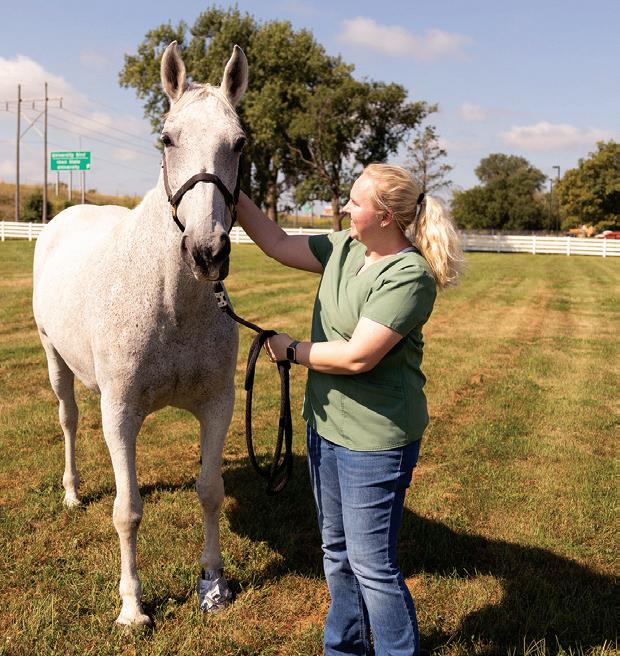
It’s been said that good veterinarians talk to animals. Great veterinarians hear them talk back.
Many of these dedicated veterinarians, skilled in the art and science of large-animal care, are educated at Iowa State University (ISU) College of Veterinary Medicine. Some go on to grow their careers at the large animal hospital at the Lloyd Veterinary Medical Center at ISU.
“The depth of expertise found at the Lloyd Medical Center cannot be matched elsewhere in the state,” says Dan Grooms, DVM, PhD, and the Dr. Stephen G. Juelsgaard, Dean of Veterinary Medicine at ISU.
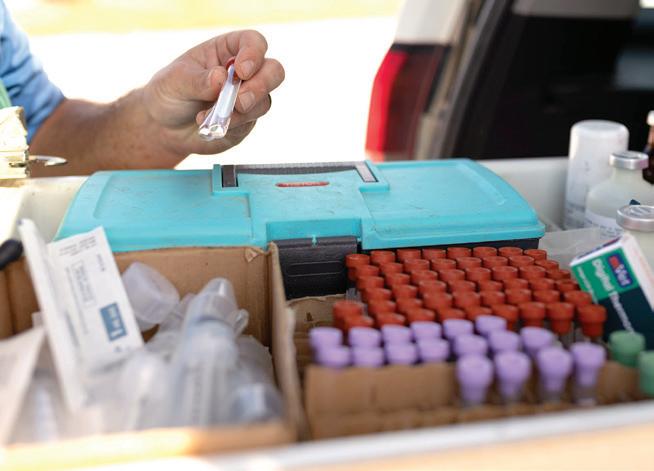
in 1879 as the country’s first public veterinary school.

“The College of Veterinary Medicine has provided care for all species of animals from the beginning,” Grooms says. “Today, about 40 to 50% of our students are interested in a largeanimal or mixed-animal practice.”
The ISU College of Veterinary Medicine is one of only 33 veterinary colleges in the U.S. “About one-third of our students come from Iowa, while another third comes from our two contract states — Nebraska and North Dakota — that don’t have a College of Veterinary Medicine,” Grooms notes.

The Lloyd Veterinary Medical Center team comprises board-certified veterinarians, veterinarians focused on a specific specialty area, residents and interns, fourth-year veterinary students and registered veterinary technicians. Some of these professionals work at the facilities in Ames, while others provide on-farm services to livestock producers in central Iowa and beyond.
“We offer 24/7 emergency care — including holidays,” says Grooms, who notes that the team also works with the Blank Park Zoo in Des Moines. “People can bring their animals to us, or we can come to them through our ambulatory service, which covers about a 40-mile radius around Ames.”
Veterinary medicine has a long history at ISU. The ISU College of Veterinary Medicine was founded

The remaining one-third of ISU’s vet-med students come from various states, from California to Massachusetts to Florida. “We also have some international students,” says Grooms, who adds that about 80% of veterinary medicine graduates nationwide are female.
Students at ISU have the opportunity to work in the Lloyd Veterinary Medical Center, which was built in 2008. This facility has approximately 130 staff, including animal caretakers. Roughly 50 veterinarians work in the center’s hospitals, including the large animal hospital.


“Our large animal hospital provides state-of-the-art care for both food animals and equine patients. As a teaching hospital, it also provides a clinical setting for our students to become proficient at diagnosing and treating health abnormalities,” Grooms says.


That might mean treating a calf with an infected joint, a goat or lamb with pneumonia, a horse suffering from lameness or colic or a large animal with a broken bone. The Lloyd Veterinary Medical Center team also conducts fertility exams and provides advanced reproductive services for large animals. This can involve embryo transfer (ET), which allows a livestock producer to quickly multiply the genetics of the top females in the herd.
“Our animal patients come from across Iowa and the Midwest, including Wisconsin, Minnesota, Illinois and other states,” Grooms says. “Some of these patients are highvalue animals economically, like show pigs or embryo-transfer calves. Other animals are high value because they are special to the owner.”
“Our ambulatory unit fills a niche, from large farms to hobby farms,” says Dr. Pat Gorden, an ISU College of Veterinary Medicine faculty member specializing in dairy production medicine. “Our goal is to get more students out on farms and give our clients options, too.”
Some clients want a second opinion or consultation, while others rely on the ambulatory unit for routine veterinary services. Sometimes, clients need on-farm visits, although many issues can be handled over the phone. “The ambulatory unit has really grown in recent years,” Gorden notes.

Sometimes, farmers and others with large animals need Lloyd Veterinary Medical Center veterinarians to make a “barn call.”
Equipped with four fully stocked mobile veterinary trucks and eight full-time clinicians, the College of Veterinary Medicine’s Veterinary Field Services team provides individual animal and herd health veterinary care for beef, dairy, swine, horses, sheep, goats and camelids (alpacas and llamas).
This service reflects two of the three missions of ISU’s College of Veterinary Medicine, including education and extension that aims to bring the university's knowledge to the people of Iowa.
“The College of Veterinary Medicine also conducts research to provide answers to key questions that the people of Iowa have about animal health and public health,” Grooms says. ISU has been a national leader in developing vaccines, from kennelcough vaccines for dogs to vaccines that help control swine diseases.
The Lloyd Veterinary Medical Center staff works year-round to make animals’ lives happier, healthier and more productive, Grooms adds. “If there’s a problem, we’re here to help.”

Recipe on Page41.
By Lydia Zerby
Embark on a culinary adventure that tantalizes your taste buds and ignites your kitchen creativity. These flavorpacked recipes are designed to transform everyday meals into extraordinary experiences.
Dive into the rich, aromatic depths of Turkey and Squash Curry, where tender turkey melds seamlessly with the hearty squash, all bathed in a luscious, spice-infused curry sauce. Next, let a vibrant and bold Sizzling Asian Beef Stir Fry captivate you with its symphony of crisp vegetables, succulent beef, and a perfect balance of savory and sweet notes, all sizzling in your wok. Finally, wake up your senses with Chilaquiles Verdes Con Huevos, a traditional Mexican dish that layers crispy tortillas with tangy green salsa, crowned with perfectly cooked eggs for a breakfast or brunch that’s both fresh and comforting. These recipes are not just about meals. They’re about moments of joy, discovery and shared delight around the table. So, tie on your apron, gather your ingredients and get ready to savor every bite of these exquisite dishes.
• 2 pounds turkey thighs, skin and bones removed, cut into 1-inch cubes
1 pound butternut squash, seeded, peeled and chopped into 1-inch cubes
• 1 yellow onion, chopped
4 cloves garlic, crushed
• 1 inch fresh ginger, peeled and grated or chopped finely
2 tablespoons curry powder
• 1 teaspoon garam masala
• 1 teaspoon cumin, ground
1 teaspoon coriander, ground
• ½ teaspoon turmeric, ground
• ½ teaspoon chili powder (add more to increase spiciness)
• 1 can (14 ounces) coconut milk
• 1 can (14 ounces) diced tomatoes, drained
• ½ cup water or stock
2 ounces fresh spinach
• Salt and pepper to taste
• Vegetable oil
• White rice, cooked according to package directions
• Optional: scallions, cilantro, lime, chopped cashews, yogurt
Cut turkey thighs into 1-inch cubes. Heat 1 tablespoon of vegetable oil in a large pot or Dutch oven over medium-high heat. Add half of the turkey pieces, season with salt and pepper, and cook until lightly browned on all sides. Remove the turkey from the pot and set aside. Repeat with remaining turkey, adding additional oil if needed.
In the same pot, add another tablespoon of oil and sauté the chopped onion until translucent.
Add the minced garlic and grated ginger, stirring for another minute.
Stir in the curry powder, ground cumin, ground coriander, turmeric and chili powder. Cook for a minute or so, stirring constantly to prevent burning.
Incorporate the drained tomatoes. Scrape up any browned bits from the bottom of the pot using the liquid released from the tomatoes.
Add the cubed squash and the browned turkey to the pot and incorporate into the mixture.
Remove the pot from the heat and stir in the coconut milk. The liquid should almost cover the turkey and squash. If there appears not to be enough liquid, add about ½ cup of water or stock.
Return the pot to low heat, cover and simmer for 25 minutes. Remove the lid, stir and then continue to simmer on low with the top off until the squash is tender and the curry has thickened a bit, about 10–15 minutes. Add salt to taste.
When ready to serve, take off the heat and stir in the fresh spinach so that it wilts.
Serve over rice and garnish with items like scallions, cilantro, lime, chopped cashews and yogurt.
Cook’s Tip: You can substitute butternut squash with sugar pumpkin, Hubbard squash or acorn squash.
Photo and recipe credit: National Turkey Federation

• 1 pound beef top sirloin steak, boneless
• 3 tablespoons water
• 4 cups (10–12 ounces) fresh stir-fry vegetable blend
• 1/2 cup red bell pepper strips
1 tablespoon vegetable oil
• 1 1/2 teaspoons crushed red pepper
• 2 cups hot, cooked brown rice
• Optional: coarsely chopped dry-roasted peanuts
Marinade
2 tablespoons soy sauce
• 1 tablespoon minced garlic
• 1 tablespoon minced fresh ginger
1 tablespoon dry sherry
• 1 teaspoon sugar
• 1 teaspoon cornstarch
Cut beef top sirloin steak lengthwise in half, then crosswise into 1/8-inch thick strips. Combine marinade ingredients in medium bowl. Add beef; toss to coat. Set aside.
Combine water, vegetable blend and bell pepper in large nonstick skillet or wok; cover and cook over medium-high heat for 4 to 5 minutes or until crisp-tender. Remove and drain vegetables; keep warm.
Heat 2 teaspoons oil in same pan over medium-high heat until hot.
Add crushed red pepper; stir-fry 30 seconds. Add 1/2 of beef; stirfry 1 to 3 minutes or until outside surface of beef is no longer pink. (Do not overcook.) Remove from pan. Repeat with remaining 1 teaspoon oil and beef.
Return beef and vegetables to pan. Cook and stir about 1 minute or until heated through. Serve over rice and garnish with peanuts, as desired.
Cook's Tip: You can also use 1 pound beef top round steak, cut 3/4 to 1 inch thick.
Recipe and photo credit: Beef. It’s What’s for Dinner
1 red onion, sliced and de-flamed
• 10 (1 ¼ pounds) tomatillos, stemmed, husked and rinsed
• 4 cubanelle peppers
• 2 poblano chiles
4 serrano chiles, divided
• ½ white onion, quartered
• 1 cup cilantro (leaves and stems) plus more leaves to garnish
• 2 cups chicken stock
• 2 limes, divided
1 ½ teaspoon ground cumin
• Pinch of kosher salt
• 5 tablespoons avocado oil, divided
• 4 garlic cloves, minced
30 (5-inch) corn tortillas, quartered and fried in peanut oil (substitute for a bag of store-bought tortilla chips)
• 6 ounces Manchego cheese, shredded 12 ounces Oaxaca cheese, shredded Mexican crema or sour cream
• 2 ripe avocados, sliced 6 to 12 large eggs, divided
De-flame the red onion by soaking the slices in cold water, 5 to 10 minutes, to remove the harsh, raw onion flavor. Drain and set aside.
Heat grill over medium heat. Oil the grates and place the tomatillos, cubanelles, poblanos, 2 serrano peppers and white onion onto grill and char all over, 10 to 15 minutes. Once the tomatillos are charred, slightly soft but still holding their shape, remove them so they don’t let their juice out onto the grill.
Place the poblanos and cubanelles into a large bowl and tightly cover with plastic wrap to steam. Once cool enough to handle, remove the skins, stems and seeds. Remove the stems from the serrano peppers. Remove the seeds to decrease heat, if desired.
To make the salsa verde, place the charred tomatillos, cubanelles, poblanos, serrano peppers, onion, cilantro (stems and all), chicken stock, 1/2 freshly squeezed lime and cumin in a blender. Purée until smooth. Season to taste with salt.
Heat 2 tablespoons of oil in a 12-inch frypan over medium heat. Add the garlic and sauté until fragrant, about 30 seconds. Pour salsa verde into the pan and heat over medium to medium-low heat
until hot, stirring periodically, about 5 to 6 minutes. Remove from the heat.
Divide the tortilla chips among 6 plates. Divide and sprinkle both cheeses over the chips, followed by hot salsa verde to coat the chips and melt the cheese.
Slice the remaining serrano peppers. Garnish each plate with a drizzle of crema or sour cream, sliced serranos, avocados, de-flamed red onions, cilantro leaves and remaining limes wedges on the side, for squeezing.
Heat the remaining 3 tablespoons of oil in a 12-inch nonstick frypan over medium-low heat. Once the oil is heated, crack 4 eggs into the pan, one at a time. Fry sunny side up, for about 1 minute. Once the whites begin to set, carefully tilt the pan and baste the top of the whites with the oil until fully set with a runny yolk. Remove and place 1 to 2 eggs on top of the chips on each plate. Repeat with the remaining eggs, as desired.
Photo and recipe credit: Incredible Egg



By Alex Potter

Although Linn County educator
Melissa James didn’t grow up on a farm, she consistently incorporates agricultural topics into the botany and biology classes she teaches at Center Point-Urbana High School. With her biology degree from Iowa State University and insights from students who live on farms, James has picked up some agricultural knowledge over the
past 33 years — but she is always looking for ways to fill in the gaps.
“I’m a biologist. That’s my first passion. As I grew up, I discovered I loved botany and horticulture. Botany has a natural tie-in with agriculture, but I also try to pull agriculture into my other courses,” explains James. “As a teacher, I’m always researching new activities, so when I stumbled upon Iowa Agriculture Literacy Foundation’s
resources, I thought, ‘holy cow, these are fabulous!’”
The Iowa Agriculture Literacy Foundation (IALF) is a nonprofit organization dedicated to educating students about the global significance of agriculture. This organization addresses a growing nationwide problem: agricultural knowledge is decreasing as more individuals leave rural areas. Executive


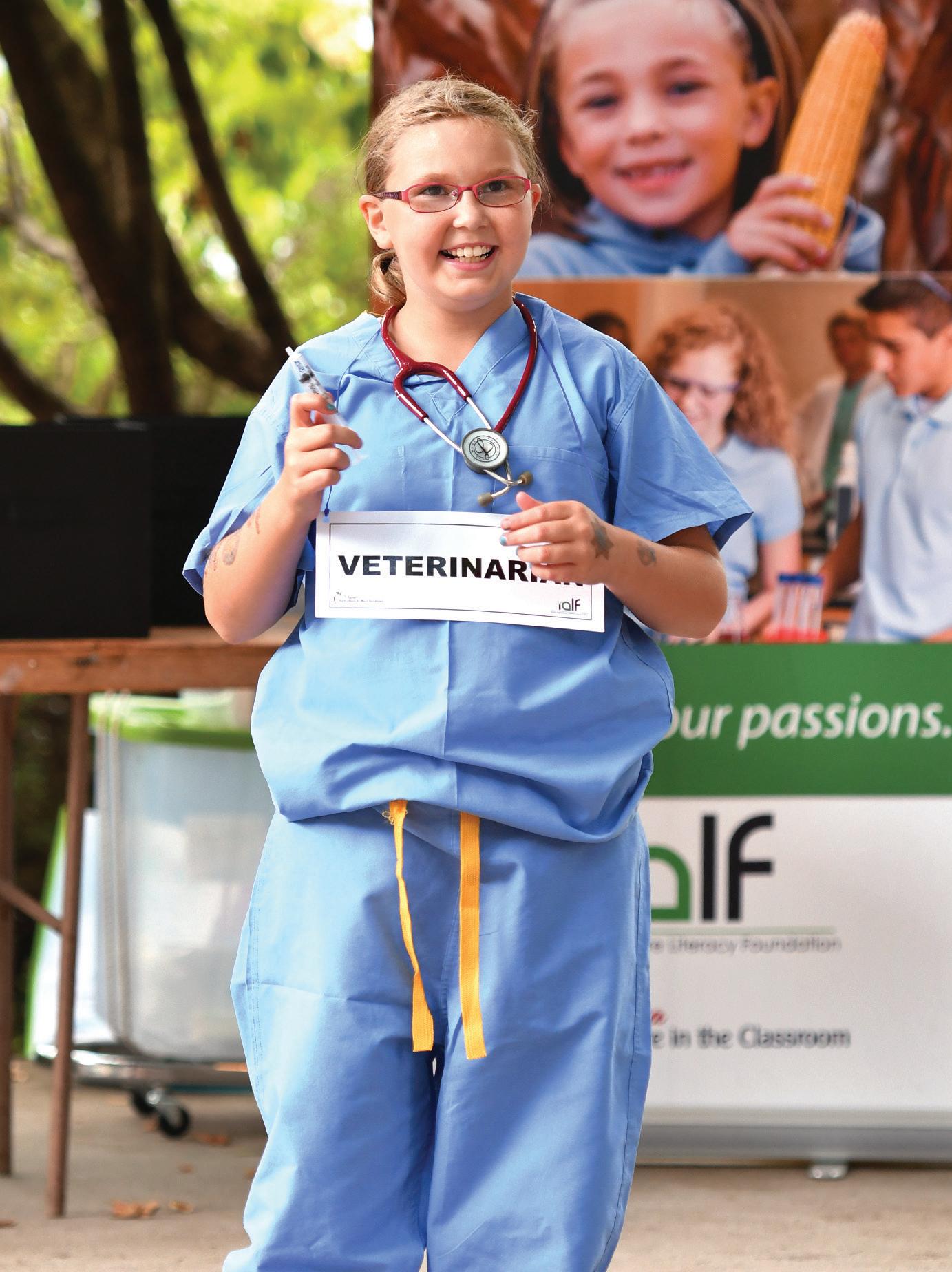


Director Kelly Foss considers bringing agriculture into the classroom a solution but realizes it’s easier said than done.
“Often, teachers don’t have a background in agriculture. Even students living in rural communities who pass cornfields daily don’t connect with agriculture anymore,” Foss admits. “People take agriculture for granted; we just don’t think about it's significance.”
Michael Bechtel, Wartburg associate professor of science education and IALF Education Advisory Council member, also recognizes educators' challenges while teaching STEM.
“Teaching agriculture can be scary for teachers. It can be difficult to explain concepts and for students to connect to their learning,” Bechtel says.
That’s where IALF steps in. The organization supplies educators with everything they need to bring agriculture into their classrooms — from free lesson plans to grants, book kits and more. IALF's Education Advisory Council is the “first and last sets of eyes,” ensuring resources meaningfully connect to agriculture while following Iowa Core science and social studies standards.
“If we try to get our communities reconnected with agriculture only from a scientific perspective, we’re going to lose students. If we try to do it without the Iowa Core standards, then we can’t involve education,” explains Bechtel.
IALF also offers professional development opportunities for educators. During the two-day sessions, educators visit farms,
wineries, meat lockers and dairy facilities to learn directly from agriculture experts. IALF Teacher Leaders also model lesson plans, which made James feel certain she could bring IALF's materials into the classroom.
“That’s the best part. IALF didn’t tell me how to implement these plans. Instead, they asked me what parts I would incorporate and what resources I still needed from them,” says James. “As a science teacher, I always do lab experiments first to work out any kinks. These professional development days helped me do that on a larger scale.”
Comfortable is exactly how Foss and Bechtel want educators to feel when implementing IALF resources.
“We’ve found that if educators teach through the lens of agriculture, they suddenly become more confident, and students buy into what they’re learning,” adds Bechtel.
IALF lesson plans have been implemented at schools in all 99 counties, reaching nearly 180,000 students in 2023 alone. James champions agriculture in her classes at Center PointUrbana High School in many ways. In discussions, she ties current events to her lessons, like the difficulties Iowa farmers faced in 2020 due to the pandemic, derecho and tariffs.
She also took advantage of IALF’s Agriculture in the Classroom Teacher Supplement Grant to install eight raised gardening beds in 2021. Every fall, her students research and choose cold-weather crops to grow, like
“IF EDUCATORS TEACH THROUGH THE LENS OF AGRICULTURE ... STUDENTS BUY INTO WHAT THEY'RE TEACHING.”
MICHAEL BECHTEL
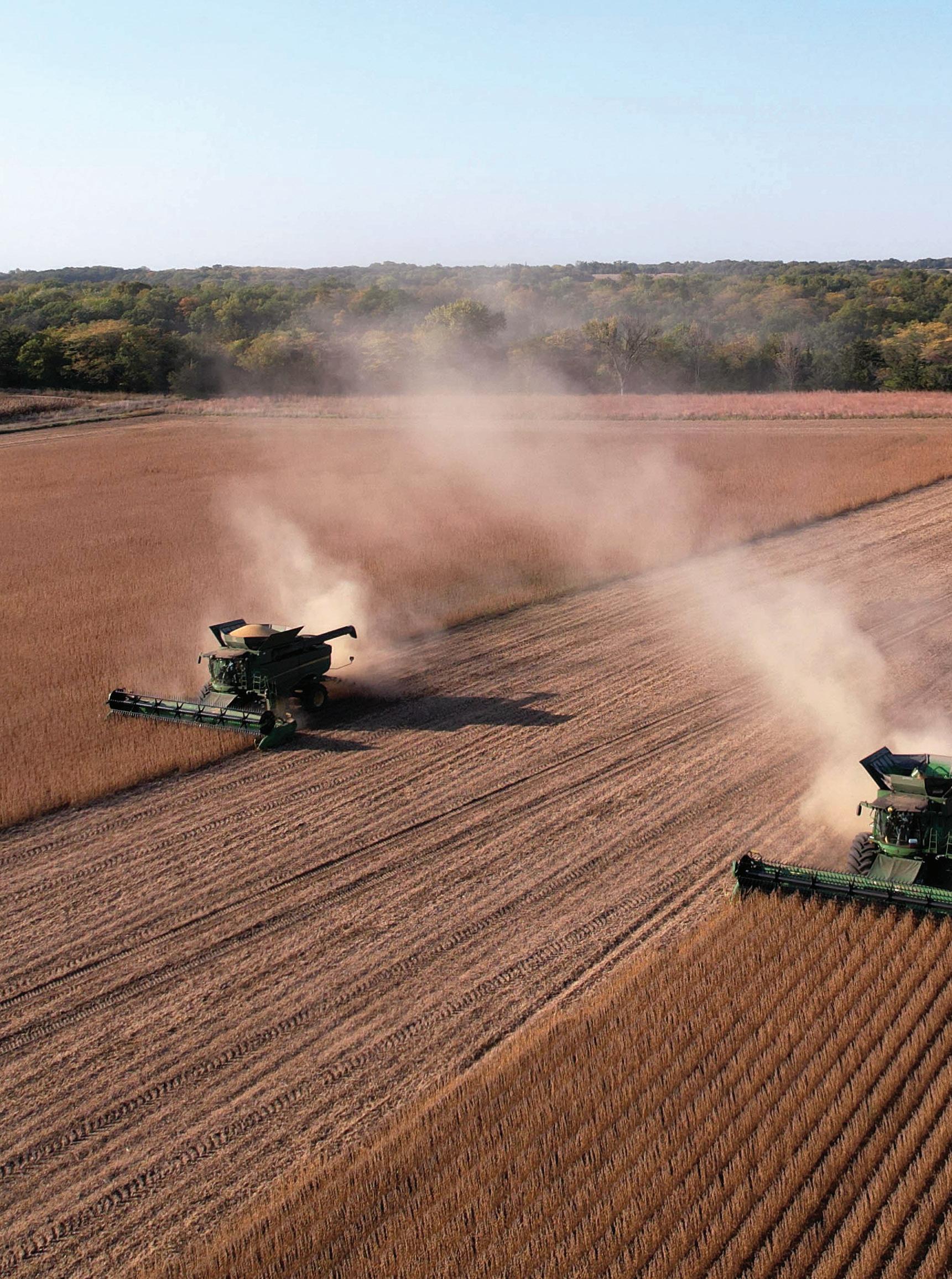
lettuce and radishes. After harvest, students take their produce home and leftovers are donated to the school’s cafeteria salad bar.
One of James’ favorite units to teach revolves around George Washington Carver’s work in agriculture. Her students research Carver’s methods to reduce soil depletion and how he convinced farmers to rotate their crops with species of legumes, like soybeans.
“I’m a George Washington Carver fan, so we take time to talk about his research and why soybeans are one of the two most important crops Iowa farmers grow,” says James.
Her efforts to reconnect students with agriculture have not gone unnoticed. In 2023, James was awarded IALF’s “Excellence in Teaching About Agriculture” Award, which honors non-agriculture educators who integrate agriculture into their classrooms. Through the work of Iowa educators, IALF is hopeful more people will understand the importance of agriculture.
“As time passes, fewer people feel connected to agriculture,” she says. “But that’s changing, and it takes organizations like IALF to make that change happen.”
By Leah Brooke

Leah Brooke, a lifelong resident of Southwest Iowa, has a deep-rooted connection to agriculture. Raised on a family farm with row crops, cattle and hogs, she has come full circle in her journey. Now, as a registered dietitian nutritionist, Leah combines her agricultural background with her expertise in nutrition, understanding how farm-raised products contribute to our overall health and well-being.
My first experience with food preservation is a core memory. My grandma had a large garden with an array of fruits and vegetables — and she always grew sweet corn. On a hot July day, the entire family would spend the day preparing corn for the freezer. We all had our assigned tasks and snuck bites when Grandma wasn’t looking! I sure do miss her corn and homemade applesauce.
Although I was exposed to various home food preservation methods early on, I didn’t dive into doing this myself until I started working as an education specialist in Food and Health for Iowa State University (ISU) Extension and Outreach. My job was to teach others about home food preservation, so I decided it was time to get my hands dirty and learn firsthand!
The main food safety concern with canning at home is botulism, a very serious foodborne illness. Following the most up-to-date research is the most important way to prevent this illness. Let’s get into the details about a few common food preservation methods: canning, freezing and dehydrating.
There are two main types of canning: hot water bath canning and pressure canning. The acidity of the food depends on what method you use. Acidic foods, generally all fruits, tomatoes, figs, pears, sauerkraut and foods where you add large amounts of acids (pickles), will need to be canned using a hot water bath canner. Low-acid foods like vegetables, meats, poultry, seafood, soups, white flesh peaches and a mixture of acid and low-acid foods need to be canned in a pressure canner. Check your elevation before canning, as tested processing times are based on boiling water temperature at sea level. Even in Iowa, some counties are higher than sea level. Bread and butter pickles and fresh peach jam have become my favorites to make and share with family and friends.
Now, let’s move on to freezing. This method is more well-known, convenient and relatively easy! The nutritional quality is preserved and is closest to fresh food than other food preservation methods. It’s important to know that freezing does not kill
microorganisms but stops their growth. Enzymes must be destroyed for a good quality product, which can be done with blanching. Choose moisture- and vaporresistant, durable and leak-proof containers. Be sure to label your items so you don’t pull them out six months later and wonder what it is.
Drying foods is simple, safe and fun! The best part of this method is that it’s easy to learn, and you just turn it on and walk away. This
method’s main food safety concern is controlling temperature and air circulation to prevent the food from spoiling. You can use a dehydrator (thermostatically controlled, electric) or an oven to dehydrate your food safely. Fruits, vegetables and herbs, tomatoes and meats are great options. My favorite is a piña colada fruit leather with three simple ingredients: pineapple chunks, applesauce and shredded coconut.
It’s fun to experiment, but it’s crucial to use up-to-date, tested

recipes from reliable sources. The National Center for Home Food Preservation and ISU Extension and Outreach are two great resources.
If you’ve been wanting to learn how to preserve your own food at home, now is the time to start. Be the one to start that family tradition like I had with my grandma and family. The satisfaction of growing your food, preserving it and opening that jar of fresh salsa in the middle of winter is beyond words.
IF YOU’VE BEEN WANTING TO LEARN HOW TO PRESERVE YOUR OWN FOOD AT HOME, NOW IS THE TIME TO START.



FIND UNLEADED 88 AT A STATION NEAR YOU
Unleaded 88 is a fuel choice that’s cheaper, better for the planet, and it’s homegrown. At your next gas station stop, don’t just fill up. Pump it Up with Unleaded 88, and cue the dance moves.